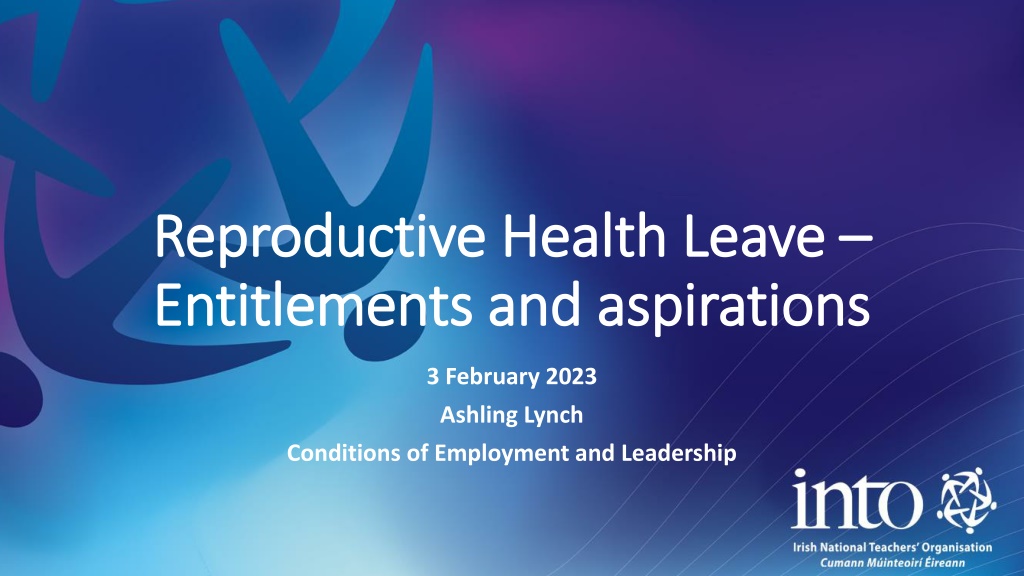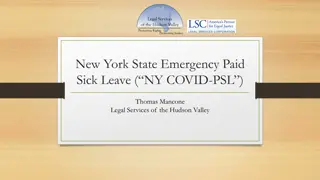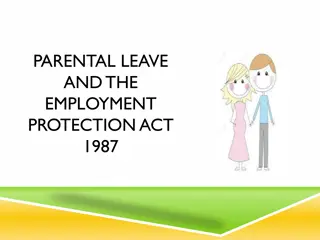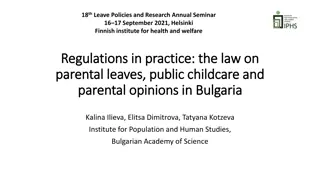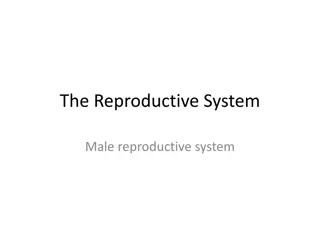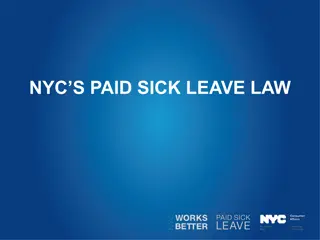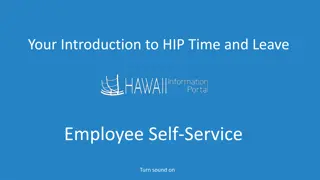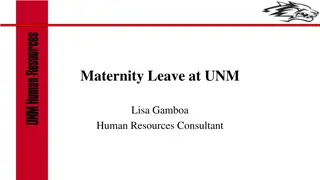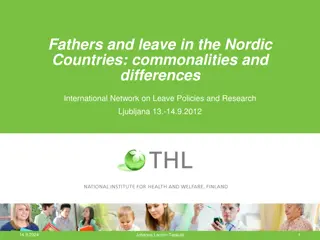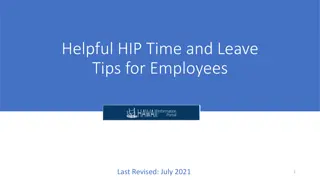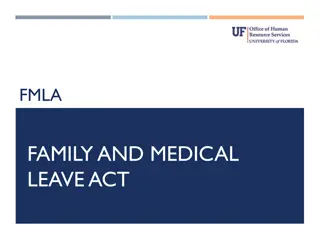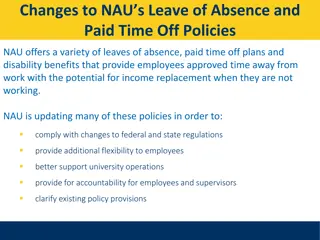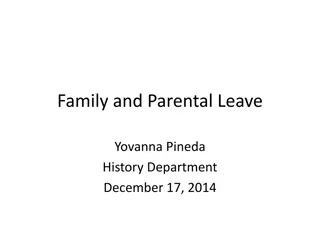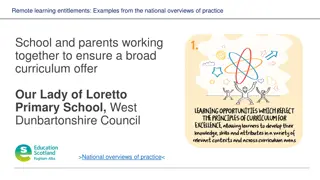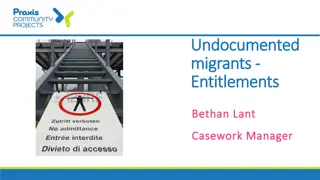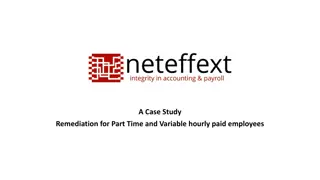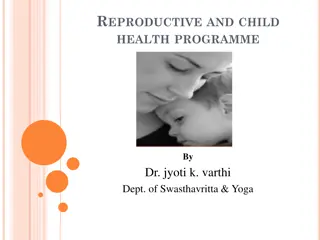Reproductive Health Leave Entitlements and Challenges Faced by Teachers
This presentation explores various aspects of reproductive health leave for teachers, including pregnancy-related sick leave, fertility treatment leave, family leave for parents, and more. It discusses current conditions, challenges faced, and potential solutions in the education sector. Attendees will gain insights into the complexities of balancing work and reproductive health needs.
Download Presentation

Please find below an Image/Link to download the presentation.
The content on the website is provided AS IS for your information and personal use only. It may not be sold, licensed, or shared on other websites without obtaining consent from the author. Download presentation by click this link. If you encounter any issues during the download, it is possible that the publisher has removed the file from their server.
E N D
Presentation Transcript
Reproductive Health Leave Reproductive Health Leave Entitlements and aspirations Entitlements and aspirations 3 February 2023 Ashling Lynch Conditions of Employment and Leadership
Structure of workshop Structure of workshop What conditions are currently in place for teachers, with context and cases Where do problems arise, and what could alleviate these issues Attendees will gain further knowledge about: Pregnancy Related Sick Leave Leave for fertility treatment Following miscarriage and stillbirth Family leave for both parents Leave entitlements for fixed-term teachers, including non-casual substitute teachers Breastfeeding breaks Teachers who become parents through surrogacy Organisation of Working Time (Reproductive Health Related Leave) Bill 2021 Some group discussion but please participate only if you are comfortable to do so, and be sensitive to the personal experiences of all attendees
Primary teachers by gender Primary teachers by gender School Year Total no of Females (including Principals) Total no of Males (including Principals) Overall Total 2020/2021 35,518 6,494 42,012 2019/2020 35,164 6,401 41,565 2018/2019 34,532 6,194 40,726 Note: Figures extracted from Payroll databases on 30th June each year which includes contracted and casual teachers. The Principal s figures are determined by teachers who hold a Principals/Acting up Principals allowance at that time.
COEL COEL Queryline Queryline 2022 2022 Carer's Leave 1% Other School Related Matters 2% Resignation 2% All other subjects 3% Subject Number of queries Percentage of total* Maternity Leave 13% Posts of Responsibility 4% Maternity and Adoptive Leave 2,509 13% Career Breaks 4% Job Share Teachers 5% Sick Leave 12% Parental Leave 1,679 9% COVID 19 Leave and Entitlements (COEL) 6% Paternity Leave 83 0.04% Family Illness Leave 234 1% Pensions and retirement 7% Career break 806 4% Brief Absences incl. Family Illness 12% Job share 907 5% 6,218 /19,187 32% Parental Leave 9% Salary, allowances, payroll 11% Staffing and Panel 9%
Pregnancy Related Sick Leave Pregnancy Related Sick Leave For discussion For discussion Scenario One - Margaret Margaret was involved in a serious car accident in March 2020, and used in excess of 183 days of sick leave at that time. Happily, she made a full recovery, and is now pregnant. Please consider: For medical appointments related to her pregnancy, what leave is available to Margaret? Will these days be at full pay, half pay, or unpaid? If Margaret needs to take some Pregnancy Related Sick Leave before her maternity leave begins, what leave is available to her? Will these absences be at full pay, half pay, or unpaid? What documentation does Margaret need to submit to support her absences on sick leave?
Pregnancy Related Sick Leave Pregnancy Related Sick Leave For discussion For discussion Scenario Two - Emma Emma is receiving fertility treatment which require her to be absent from school regularly, for short periods. Please consider: What leave is available to Emma? What documentation will she have to submit to support her absences? Can Emma choose not to disclose the nature of her absences to her principal? In what circumstances may Emma s principal make a referral to Medmark in respect of these absences?
Pregnancy Related Sick Leave Pregnancy Related Sick Leave For discussion For discussion Scenario Three - Paul Paul and his wife are due their first baby this year. Please consider: For medical appointments related to the pregnancy, is there any leave available to Paul? What documentation, if any, will Paul need to provide to support these absences? What leave will be available to him for attending antenatal classes with his wife? What leave is available to Paul when his wife goes into hospital to deliver their baby?
Pregnancy Related Sick Leave Pregnancy Related Sick Leave Teachers ordinary sick leave scheme provides for 183 days of paid sick leave in a rolling four year period, with a maximum of 92 days on full salary in any twelve month period (after which paid sick leave will be at half-pay) A teacher will never drop below half-pay when a condition is pregnancy related, irrespective of four-year sick leave record If sick leave in the rolling four-year period has been exhausted, sick leave entitlement is extended at half-pay by the number of days that were pregnancy related (e.g. I use 70 days PRSL. After my maternity leave, I return to work and break my leg. When I reach 183 day limit I do not move to TRR, but instead have an extension available, for 70 days half-pay sick leave.)
Pregnancy Related Sick Leave Pregnancy Related Sick Leave why isn t it distinct from normal sick leave? why isn t it distinct from normal sick leave? North Western Health Board v Margaret McKenna Background Ms McKenna was a nurse, employed by the N.W. Health Board, who became pregnant in 2000. She was on sick leave for almost her entire pregnancy Her sick leave scheme at the time provided for up to 365 days of paid sick leave in a rolling four year period, limited to 183 days on full pay in a single twelve months, after which half-pay would be applied The sick leave scheme made no distinction between ordinary and pregnancy related sick leave Ms McKenna moved to half-pay during her pregnancy, and as she was unfit to return following maternity leave, she returned to half-pay sick leave afterwards
Ms McKenna challenged her treatment before the Equality Officer, arguing That she had suffered discrimination contrary to Directive 76/207 inasmuch as her pregnancy-related illness had been treated in the same way as a 'normal' illness and her period of absence offset against her overall sick-leave entitlement That placing her on half pay after the 183-day period during which she had been entitled to full pay constituted unfavourable treatment in respect of pay contrary to Article 141 EC and Directive 75/117 Cited European Treaty law which protects against sex discrimination, and European directives governing equal pay and equal treatment for men and women in the workplace Upheld by Equality Officer, who ordered the Health Board to pay arrears and compensation The Health Board brought an appeal to the Labour Court, which referred the case to the ECJ
European Court of Justice, summary of ruling European Court of Justice, summary of ruling North Western Health Board v Margaret McKenna North Western Health Board v Margaret McKenna It is not contrary to EU rules on discrimination between men and women in the workplace to treat pregnancy-related illnesses the same as any other illness A sick leave scheme is not discriminatory so long as male and female workers are subject to the same policies Pregnant workers must be protected, so the level of pay during a period of pregnancy related sick leave must not be so low as to undermine this objective During later periods of sick leave, which have been offset by earlier PRSL, the rate paid to the female worker should not be lower than the minimum amount to which she was entitled during the PRSL
Wording from the Wording from the European Court of Justice ruling European Court of Justice ruling North Western Health Board v Margaret McKenna North Western Health Board v Margaret McKenna as it stands at present, Community law does not require the maintenance of full pay for a female worker who is absent during her pregnancy by reason of an illness related to that pregnancy A rule of a sick-leave scheme which provides, in regard to female workers absent prior to maternity leave by reason of an illness related to their pregnancy, as also in regard to male workers absent by reason of any other illness, for a reduction in pay in the case where the absence exceeds a certain duration, provided that the female worker is treated in the same way as a male worker who is absent on grounds of illness and provided that the amount of payment made is not so low as to undermine the objective of protecting pregnant workers; A rule of a sick-leave scheme which provides for absences on grounds of illness to be offset against a maximum total number of days of paid sick leave to which a worker is entitled over a specified period, whether or not the illness is pregnancy-related, provided that the offsetting of the absences on grounds of a pregnancy-related illness does not have the effect that, during the absence affected by that offsetting after the maternity leave, the female worker receives pay that is lower than the minimum amount to which she was entitled during the illness which arose while she was pregnant
Impact of ECJ ruling on teachers PRSL Impact of ECJ ruling on teachers PRSL For Ms McKenna, this meant that only the payment of half-pay provided for under her sick leave scheme was protected during her pregnancy, and she was entitled to have her access to sick leave following her pregnancy extended, at half-pay At that time, teachers only had full-pay sick leave, for 365 days for an ordinary illness As payment for PRSL could not undermine the objective of the protection of pregnant workers, the minimum payment under the sick leave scheme was protected, and for teachers this was full pay In 2013, when half-pay was introduced half-pay sick leave became the minimum payment under the terms of the sick leave scheme, which would meet the objective of the protection of pregnant workers The extensions available for PRSL, which had heretofore been at full pay, became half-pay
What leave is currently available What leave is currently available during pregnancy? during pregnancy? Leave with pay for pregnant women to attend all medical appointments related to pregnancy Leave with pay for pregnant women to attend a full set of antenatal classes for one pregnancy, and the last three classes for subsequent pregnancies Pregnancy related sick leave Expectant fathers and partners have leave with pay to attend two antenatal classes immediately prior to delivery Family Illness Leave may be appropriate for antenatal appointments, but no specific leave for this purpose
When receiving fertility treatment When receiving fertility treatment No specific leave provision. Under the terms of circular 54/2019, sick leave may be used: when absent for the purpose of obtaining medical related services (e.g. Doctor/Dentist) provided such appointments could not have been arranged outside of regular working hours or working days. So, certified sick leave may be used to attend for fertility treatment, subject to a maximum of 183 days paid sick leave in a rolling four year period.
Premature delivery Premature delivery If a teacher s baby is born prematurely (before maternity leave is due to begin), maternity leave must begin on the day of the birth but the teacher will be entitled to Extended Maternity Leave For Premature Birth The extended maternity leave will commence at the end of the standard 26 week period of paid statutory Maternity Leave. Teacher will notify Maternity Benefit section of DSP, confirming the date the baby was born and the number of weeks gestation. DSP will determine the entitlement to Extended Maternity Leave For Premature Birth and confirms this in writing. The teacher will provide a copy of the letter from the DSP to their school who will notify the DE so that the additional leave may be recorded on the OLCS.
Following pregnancy loss Following pregnancy loss If a teacher is more than 24 weeks pregnant, or if birth weight is more than 500g, or if baby is born alive full statutory maternity leave, paid and unpaid, is available New bereavement leave circular 78/2022 allows for ten working days for the father, or partner of the mother, in addition to their paternity leave entitlement after 24 weeks gestation Earlier than 24 weeks pregnancy, recovery from miscarriage (for both parents) will be under ordinary terms of sick leave scheme
Leave following birth or adoption Leave following birth or adoption Following delivery, mothers are entitled to: Paid maternity leave for 26 calendar weeks; Statutory additional unpaid maternity leave, for a maximum of 16 weeks. Non-statutory additional unpaid maternity leave to the end of the school year in which it s taken, i.e. 31 August. Following adoption: 24 weeks of fully paid Adoptive Leave, and up to 16 weeks of unpaid leave
Leave following birth or adoption Leave following birth or adoption Fathers and those whose partners have babies are entitled to: Paid paternity leave for two weeks All parents are entitled to: Seven weeks of Parent s Leave during first two years (unpaid by DE, but with DSP benefit of 262 p.w.) Up to 26 weeks of unpaid Parental Leave, available until child turns thirteen, or sixteen if the child has a long-term illness or disability
Leave Leave for non for non- -permanent teachers and permanent teachers and new appointees new appointees Teachers employed in a fixed term or non-casual substitute capacity are entitled to avail of paid and unpaid maternity leave for the duration of their contract of employment. A non-casual substitute will have to use the Substitute for a Substitute form to claim pay while on maternity leave. A new appointee permanent, fixed-term, or non-casual substitute will be entitled to her Maternity Leave from the outset of her contract.
Paternity Leave Paternity Leave Until 2016, no statutory entitlement to Paternity Leave, teachers had access to three days of paid leave Paternity Leave and Benefit Act 2016 provides for statutory entitlement to two weeks of leave to be used within six months of birth, or placement of the child in the case of adoption CSO figures for 2021 4.3% of workers took paid maternity or adoptive leave, only 1.7% took paternity leave No statutory entitlement to full salary Paternity Benefit of 262 p.w. may be paid by the DSP, and employer can top-up to full salary (and the DE does top-up salaries for teachers)
Importance of paternity, parents, and Importance of paternity, parent s, and parental leave parental leave Child s wellbeing, supports bonding with parent Encourages more gender equal sharing of caring responsibilities Supports women returning to the labour market (and reduces motherhood penalty ) Positive impact on work-life balance for parents Reduce gender pay gap and pension gap
Factors affecting uptake of leave Factors affecting uptake of leave for fathers for fathers Family income maintaining at or near 100% of normal income while on leave Flexibility in how leave may be used, and the timing of the leave Leave entitlement for the individual parent on a use it or lose it basis not a shared family provision INTO strenuously objected to DE refusal to top-up salaries for Parent s Leave a disincentive for fathers to avail of this leave entitlement
Caring responsibilities and gender Caring responsibilities and gender 9 July 2019 report by ERSI and Irish Human Rights and Equality Commission, Caring and Unpaid Work in Ireland found: Irish people spend an average of 16 hours per week on caring and 14.5 hours on housework On average, women spend double the time of men on caring and more than twice as much time on housework. Recommendations of the report: Social and employment policies that support carers, facilitate the combination of care and employment and encourage greater male participation in care The need to address the clear connection between caring responsibility and gender inequality in employment. Without greater equality in terms of unpaid work, greater gender equality in the labour market is unlikely to be achieved.
Caring responsibilities and Caring responsibilities and school leadership school leadership In 2020/21 school year teaching population is 85% female 33% of Primary Principals are male, 67% female Parental Leave Act Section 15(a): An employee who exercises or proposes to exercise an entitlement under section 15 [Return to Work] may request, in accordance with subsection (2), changes to his or her working hours or patterns, or both, to apply for a set period of time following his or her return to work Teachers Parental Leave scheme addresses this requirement through the availability of job sharing but job share is not available to Principal teachers INTO has sought the expansion of interschool job share scheme to include Principal teachers working in another school
For discussion For discussion Please consider In your experience, do male teachers avail of all the family leave which is available to them? What measures would support or encourage greater uptake of family leave for male teachers? Is the role of principal compatible with family leave and parenting young children, for male or female teachers? What might improve this situation?
Breastfeeding breaks Breastfeeding breaks Under existing Maternity Protection Act, statutory entitlement to one hour per day when baby is under 26 weeks of age May be taken as full hour, two 30 minute breaks, or three 20 minute breaks Under circular 60/2018, discretionary leave for teachers with breastfeeding babies up to two years of age Employers should take reasonable measures to facilitate the pattern of breastfeeding breaks as requested, while having due regard to the welfare and educational needs of pupils. Work Life Balance and Miscellaneous Provisions Bill extends statutory entitlement to breastfeeding breaks for six months following birth, up to two years
For discussion For discussion If the Work Life Balance and Miscellaneous Provisions Bill secures a statutory entitlement to breastfeeding breaks, for babies up to the age of two, how might this be managed in schools? How has your school accommodated breastfeeding breaks for teachers to date? In your experience, do teachers feel comfortable and confident requesting these breaks at present?
Teachers who become parents Teachers who become parents through surrogacy through surrogacy Under current Irish law, the intended mother does not have a legal relationship to their child who is born through surrogacy Therefore, the intended mother currently has no statutory entitlement to Maternity Leave Parental Leave 26 weeks of unpaid leave will be available as she is acting in loco parentis to the child Parent s Leave and Benefit up to seven weeks will be available as she is the spouse or partner of the child s father The father of a baby born through surrogacy will be entitled to his Paternity Leave, Parent s Leave, and Parental Leave In a same sex couple, the partner of the father of a child born through surrogacy may use Parental Leave, as he is acting in loco parentis to the child, and Parent s Leave and Benefit up to seven weeks will be available as the spouse or partner of the child s father
Surrogacy Surrogacy access to paid leave access to paid leave Z. v A government department, the Board of management of a community school 18 March 2014 the European Court of Justice ruled that an Irish teacher (Ms Z), whose child was born through surrogacy, had no legal entitlement paid Adoptive Leave or Maternity Leave Ms Z and her husband are genetic parents, but as a result of a rare medical condition, Ms Z could not carry her pregnancy Complaint brought to Equality Tribunal in 2013, claiming discrimination on the grounds of sex, family status, and disability
Surrogacy Surrogacy access to paid leave access to paid leave Outcome of Z. v A Government department, the Board of management of a community school The European Court upheld the position of the Irish court, ruling that Ms Z did not fall within the scope of the Pregnant Worker s Directive, as the Directive presupposes that the worker has been pregnant or has given birth to a child. Although maternity leave is also intended to ensure that the special relationship between a woman and her child is protected, that objective concerns only the period after pregnancy and childbirth The claim of discrimination on the grounds of sex was not upheld, as fathers in this situation also had no leave entitlement (Note: this case pre-dates statutory entitlement to Paternity Leave.) The claim of discrimination on the grounds of disability also failed, with the judgement stating that, although a woman s inability to bear her own child may be a source of great suffering it does not amount to disability . The concept of disability within the EU Employment Equality Framework Directive presupposes that the limitation, from which the person suffers, in interaction with various barriers, may hinder that person s full and effective participation in professional life on an equal basis with other workers .
Organisation of Working Time (Reproductive Organisation of Working Time (Reproductive Health Related Leave) Bill 2021 Health Related Leave) Bill 2021 Research undertaken by Equality Committee, including an extensive survey in February 2019. (2,271 responses received) Motion to Congress 2019; moving and personal contributions from members Worked with then Senator Ivana Bacik on the Organisation of Working Time (Reproductive Health Related Leave) Bill 2021 Key provisions of the bill include: A new leave category so workers are not using sick leave or annual leave to deal with issues around reproductive health Up to 20 days leave following miscarriage Up to ten days leave to obtaining reproductive health related treatment Protects the employment rights of workers availing of this leave
For discussion For discussion Gaps in current reproductive and family leave arrangements include: Specific leave provision for appointments for fertility treatment Leave entitlement for miscarriage before 24 weeks Salary during Parent s Leave to be topped-up by the DE Leave entitlements for teachers who become parents through surrogacy Flexible work option for Principals, who cannot avail of job share, and whose Deputy Principals do not receive an acting-up allowance for any absence shorter than 30 days Please consider Which of these would make the greatest difference to you or your colleagues? What other measures would improve teachers conditions in respect of reproductive health? Is teaching a family friendly profession? Are teachers aware of their existing leave entitlements? If not, what might be done to improve this knowledge?
Questions or comments?
INTO Queryline: 01 804 7700 info@into.ie INTO Leave Estimator
